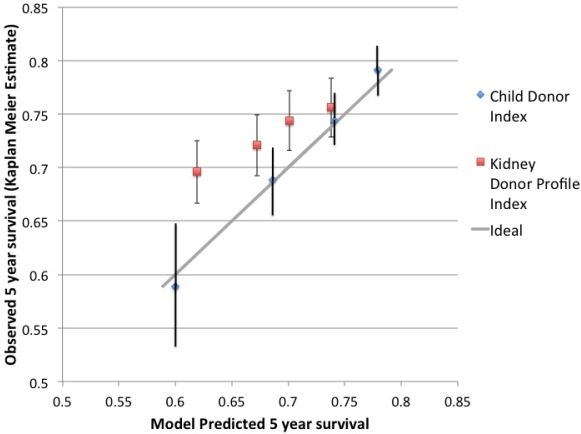Predicting Survival of Deceased Donor Kidneys from Children Under Ten
University of Chicago, Chicago, IL.
Meeting: 2015 American Transplant Congress
Abstract number: 290
Keywords: Allocation, Ethics, Kidney transplantation, Pediatric
Session Information
Session Name: Concurrent Session: Kidney: KDPI and Non Ideal Kidneys
Session Type: Concurrent Session
Date: Monday, May 4, 2015
Session Time: 4:00pm-5:30pm
 Presentation Time: 4:00pm-4:12pm
Presentation Time: 4:00pm-4:12pm
Location: Room 118-AB
Background: The United Network for Organ Sharing (UNOS) has adopted a new allocation algorithm that uses a Kidney Donor Profile Index (KDPI) based on 10 donor characteristics that predict kidney graft survival in adult recipients. We hypothesized that 1) KDPI would not accurately predict child donor (<10 years of age) graft survival in adult recipients; and 2) that a more accurate index could be developed for this population.
METHODS: Using the UNOS Standard for Transplant Analysis and Research (STAR) dataset, we compared KDPI predicted graft survival for kidney transplants performed during 2000-2010 from child donors into adult recipients with observed survival (based on Kaplan Meier estimates [KM]). A Cox regression using all donor characteristics was performed and significant covariates were identified using backwards selection to define a novel predictive model, the Child Donor Index (CDI). We also compared CDI predicted graft survival with observed survival.
RESULTS: 3,785 kidney alone, first time adult recipient transplants from child donors occurred in the 2000-2010 time period and were followed through 12/31/2013. KDPI predicted significantly lower survival than observed KM survival for 3 out of 4 quartiles of child donor kidneys (p<0.001, see figure) due in part to the fact that only 3 of 10 KDPI variables were predictive for child donors. A modified Hosmer-Lemeshow [H-L] goodness-of-fit test demonstrated a poor fit (p < 0.00001). The final Cox regression for CDI included age as a categorical (not continuous) covariate and other novel covariates such as en bloc vs single kidney graft. Dividing child donors into 4 groups based on CDI scores yielded no significant differences between predicted and observed survivals for all child donors (p>0.3, see figure) and a good H-L fit (p=0.73). When replacing KDPI with CDI, 54.3% of child donor kidneys had >5% different 5 year predicted survival.

CONCLUSIONS: KDPI is not predictive of child donor kidney survival. Implementation of an alternative predictive algorithm using different factors based on child donor population alone would improve predictive accuracy which would help fulfill the efficiency aims of the new allocation system.
To cite this abstract in AMA style:
Parker W, Thistlethwaite J, Ross L. Predicting Survival of Deceased Donor Kidneys from Children Under Ten [abstract]. Am J Transplant. 2015; 15 (suppl 3). https://atcmeetingabstracts.com/abstract/predicting-survival-of-deceased-donor-kidneys-from-children-under-ten/. Accessed November 16, 2025.« Back to 2015 American Transplant Congress
